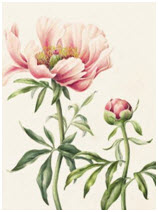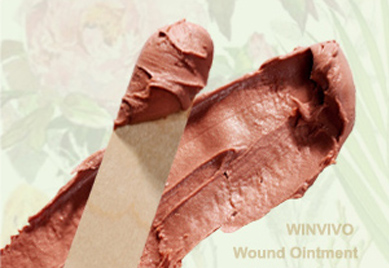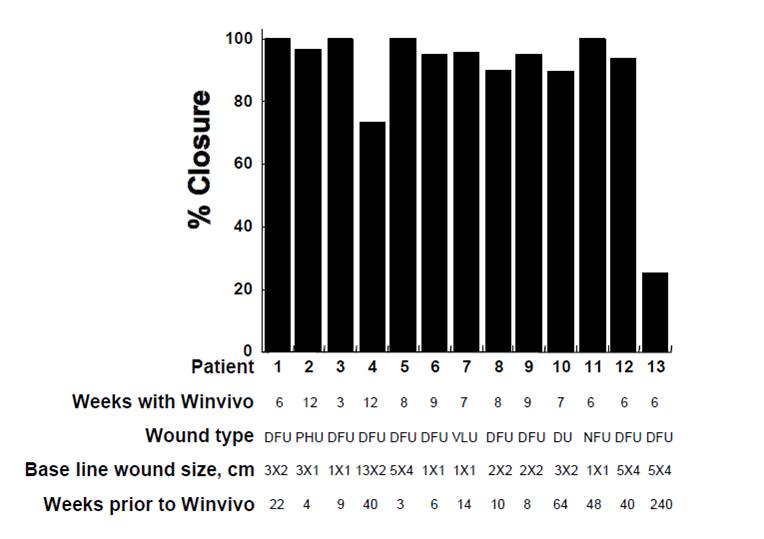Tree Peony bark (Paeonia suffruticosa Andr.)
 The dried bark of Paeonia suffruticosa Andr. is used in the preparation of the WINVIVO Wound Ointment.
The dried bark of Paeonia suffruticosa Andr. is used in the preparation of the WINVIVO Wound Ointment.
Traditional Uses of Tree Peony Bark (Paeonia suffruticosa Andr.)
- The first record for medical use of tree peony bark has been appeared in the Chinese medical literature of The Divine Farmer’s Materia Medica (25 A.D. to 220 A.D).
- In Traditional Chinese Medicine, this botanical is used for clearing heat
and cools blood, invigorating blood circulation and dispersing blood
stasis.
Modern Research - Tree Peony Bark (Paeonia suffruticosa Andr.)
- Tree peony bark is reported with the following pharmacological properties: anti-inflammatory. antibiotic
and anti-hypertensive. - It has demonstrated strong anti-inflammatory actions according to laboratory studies.
- The mechanism of the anti-inflammatory effect is attributed to inhibition of prostaglandin synthesis and decreased permeability of the blood vessels.
- This botanical has also been shown to have a protective effect against ischemia of the heart.
Vascular dilation by paeonol--a mechanism study.
Vascul Pharmacol. 2010 Sep-Oct; 53(3-4):169-76.
Li YJ, Bao JX, Xu JW, Murad F, Bian K.
Murad Research Institute for Modernized Chinese Medicine, Shanghai University of Traditional Chinese Medicine, Shanghai, PR China.
AbstractThe goal of this study was to investigate the mechanism underlaying the vasodilatory effect of paeonol, a major active element from the root bark of Chinese herbs Paeonia suffruticosa Andr. and Cynanchum paniculatum (Bunge) Kitagawa. Paeonol relaxed isolated rat aorta rings by 95.6% while the 10(-6)M forskolin-induced vasodilatation used as 100%. The EC(50) of vasodilatation by paeonol is 2.9x10(-4) M. Although paeonol exerted endothelium-independent relaxation, L-NAME treatment inhibited paeonol-induced vasodilation of endothelium intact rings, while indomethacin did not. Both L-NAME and ODQ did not affect paeonol relaxation in the rings without endothelium. In addition, paeonol markedly elevated NO generation in cultured endothelial cells. Pre-treatment of propranolol, glibenclamide, TEA and BaCl(2) did not affect paeonol relaxation of endothelium removed rings. On the other hand, pre-treated of rings (without endothelium) with paeonol markedly blocked vasoconstriction induced by AngII, PGF(2alpha), 5-HT, dopamine, vasopressin, endothelin-1 and PE. The paeonol incubation also significantly attenuated KCl-induced contraction which mainly depended on Ca(2+) influx. In Ca(2+)-free medium (containing 10(-4) M of EGTA and 60 mM of KCl), paeonol suppressed the contraction curve of CaCl(2). In addition, paeonol also inhibited contraction by PE in Ca(2+) free solution (containing 10(-4) M of EGTA) which mainly relied on intracellular Ca(2+) release. Whole-cell patch-clamp experiment showed that paeonol shifted the I-V curve and the peak value of calcium currents was significantly inhibited. In conclusion, our study suggested that voltage-dependent and receptor-operated Ca(2+) channel, as well as intracellular Ca(2+) release were all inhibited by paeonol. An intracellular Ca(2+) regulatory mechanism may be responsible to potent vasodilatory effect of paeonol.
Traditional Chinese medicine for atopic eczema: PentaHerbs formula suppresses inflammatory mediators release from mast cells.
J Ethnopharmacol. 2008 Oct 30; 120(1):85-91.
Chan BC, et al.
Institute of Chinese Medicine, The Chinese University of Hong Kong, Shatin, New Territories, Hong Kong, China.
Abstract
BACKGROUND: PentaHerbs formula (PHF) containing Cortex Moutan, root bark of Paeonia suffruticosa Andr. (Ranunculaceae), Cortex Phellodendri, bark of Phellodendron chinensis Schneid. (Rutaceae), Flos Lonicerae, flower of Lonicera japonica Thunb. (Capri-foliaceae), Herba Menthae, aerial part of Mentha haplocalyx Briq. (Labiatae) and Rhizoma Atractylodis, rhizome of Atractylodes lancea (Thunb.) DC. (Compositae) at the ratio of 2:2:2:1:2 was useful in the management of eczema.
AIM OF THE STUDY: Since the mechanism of action of PHF is not known, we aimed to investigate the actions of PHF on mast cell activation.
MATERIALS AND METHODS: Effects of aqueous extracts of PHF and individual component herb on mediator release from rat peritoneal mast cells (RPMCs) and cytokine production from HMC-1 were investigated.
RESULTS: PHF, Cortex Moutan and Herba Menthae significantly attenuated histamine release and prostaglandin D(2) synthesis from RPMC activated by anti-IgE and compound 48/80 (p<0.05). While Flos Lonicerae and Rhizoma Atractylodis suppressed only mediator release from compound 48/80 activated RPMC, Cortex Phellodendri potentiated only anti-IgE induced mediator release (p<0.05). However, with the exception of Cortex Moutan, PHF and the other four component herbs failed to affect cytokine production in HMC-1.
CONCLUSIONS: Although individual herbs demonstrated different modulating effects on mast cells, inhibition of inflammatory mediator release from mast cells would contribute to the therapeutic efficacy of PHF.
Paeonol attenuates high-fat-diet-induced atherosclerosis in rabbits by anti-inflammatory activity.
Planta Med. 2009 Jan; 75(1):7-11.
Li H, Dai M, Jia W.
Anhui College of Traditional Chinese Medicine, Hefei, PR China.
Abstract
Cortex Moutan (Paeonia suffruticosa Andrews, Ranunculaceae) has several uses in traditional medicine, such as analgesic, antipyretic, and anti-inflammatory applications and use in the prevention of thromboembolic diseases. Paeonol, a main active component in Cortex Moutan, possesses various pharmacological activities, particularly an anti-atherosclerosis effect. However, so far there have been no reports evaluating the anti-inflammatory action of paeonol in atherosclerosis therapy. The purpose of this study was to investigate the association of the therapeutic effect of paeonol on atherosclerotic rabbits with its anti-inflammatory action. The atherosclerotic model was developed in 24 rabbits fed a high-fat diet for 12 weeks. Twelve rabbits on the high-fat diet then were administered with paeonol (p.o) for a subsequent 6 weeks at the doses of 75 mg/kg and 150 mg/kg. Histological analysis showed significant improvement in atherosclerosis plaque in the paeonol groups. Moreover, the blood levels of TNF- alpha, IL-1 beta, and CRP and the translocation of NF- kappaB to the nucleus were significantly suppressed in paeonol groups, as was the inhibition of lipid peroxidation. In conclusion, these findings suggest that the anti-inflammatory action of paeonol may contribute to its anti-atherosclerosis effect.
WINVIVO Wound Ointment:
Multi-Functional Botanical Therapy
Clinical Studies
- Difficult-to-Heal Wounds
Clinical Case Reports
- Cases #1A-6A
- Cases #1B-8B
- Cases #1C-7C
- Cases #1D-4D
- Cases #1E-2E
- Cases #1F-6F
- Cases #1G-5G
- Case #1H
- Case Series #1I
- Case Series #1J
Privacy Policy | Disclaimer | Return Policy | Contact Us
© 2009-2021 WinVivo Corporation All Rights Reserved




